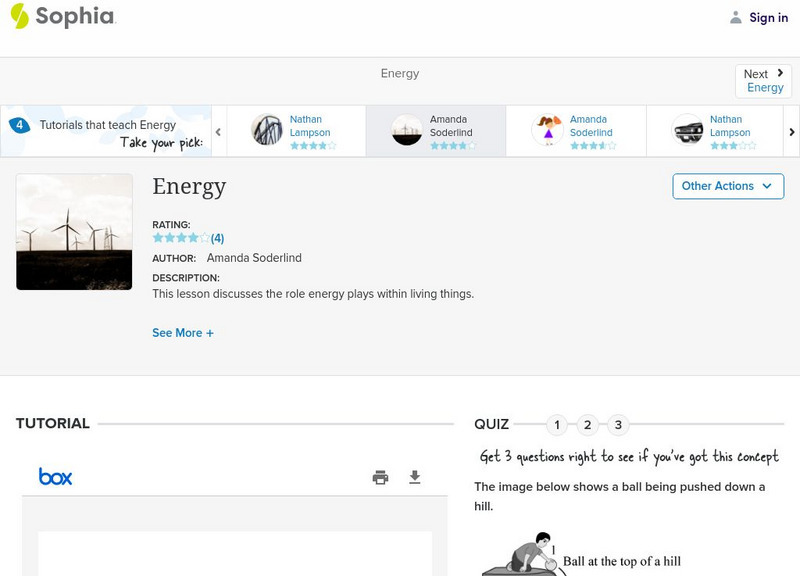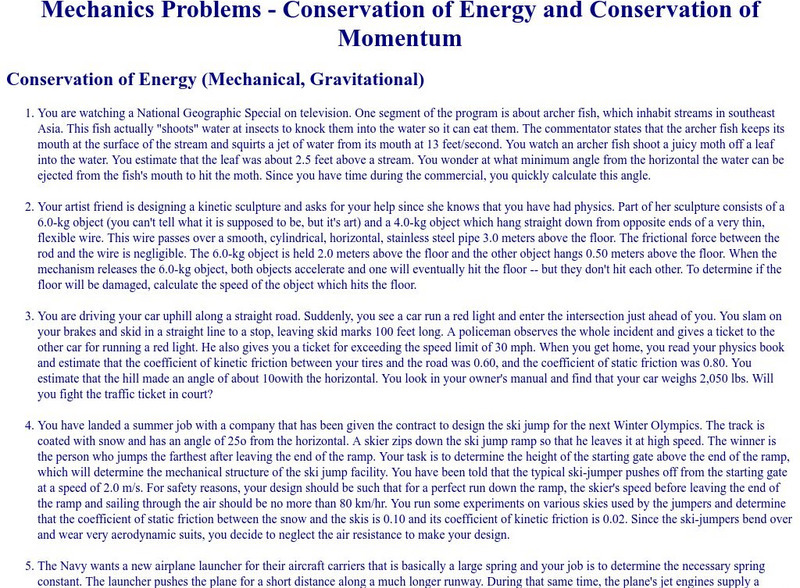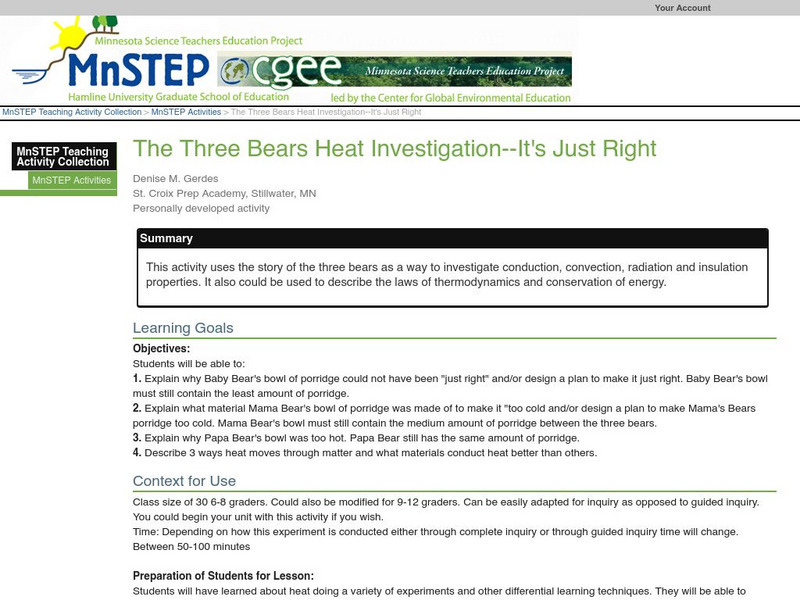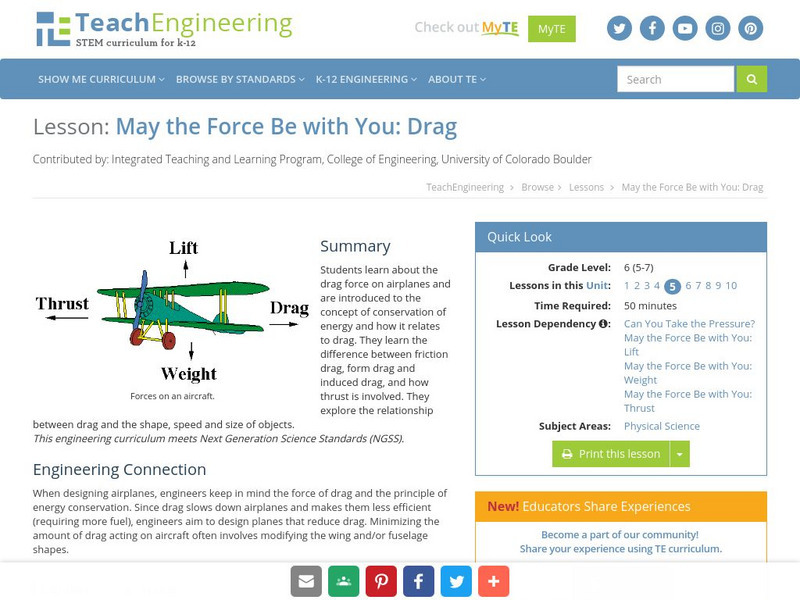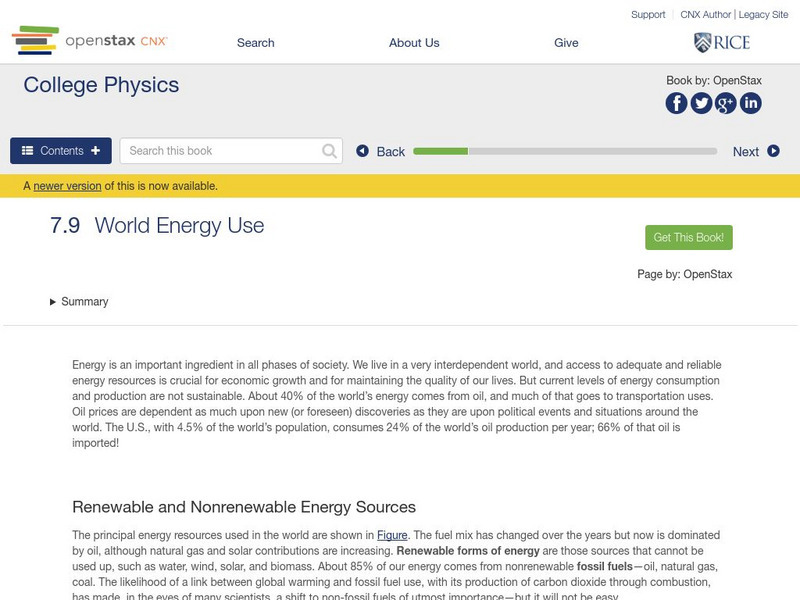Hi, what do you want to do?
Massachusetts Institute of Technology
Mit: Open Course Ware: Force and Potential Energy
The activity investigates conservation of energy. Some topics explored are friction, kinetic energy, conservation of energy, and potential energy. The resource consists of video clips, lecture notes, practice problems, and exam...
Sophia Learning
Sophia: Energy
This tutorial explains the difference between potential and kinetic energy. It also introduces the Law of Conservation of Energy.
Physics Aviary
Physics Aviary: Practice Problems: 2 D Momentum Conservation With Energy
Students must predict the KE added to the system when a Kuiper Belt Object is hit with an explosive charge. Students must first look at the momentum of each piece after the explosion to determine the original speed of the Kuiper Belt...
US Department of Energy
U.s. Department of Energy: Energy Savers
Find information on everything from buying energy-efficient products to using the proper landscaping for particular climates to conserve resources. Starting with an energy assessment, this website will help users reduce their consumption...
US Department of Energy
Us Dept. Of Energy: Urbita Elementary School: Linda Gregory: Draft O Meter [Pdf]
Students will observe drafts in homes and in the classroom to determine if or how much heat or air conditioning is escaping. How can the rooms be made more energy efficient?
State Energy Conservation Office-Texas
State Energy Conservation Office: The Rewards of Renewable Energy [Pdf]
The advantages of using renewable energy sources, such as the sun and the wind, are explained.
CK-12 Foundation
Ck 12 Exploration Series: Simulations: Physics: Roller Coaster
[Free Registration/Login Required] Learn about the conservation of energy in the context of a roller coaster.
University of Minnesota
University of Minnesota: Conservation of Momentum
This site provides a set of four Physics problems dealing with the conservation of momentum principle.
Georgia State University
Georgia State University: Hyper Physics: Relativistic Energy
A mathematically understandable presentation of relativistic energy. Parts include Relativistic Energy, Rest Mass Energy, Conservation of Energy, Pair Production, Relativistic Kinetic Energy, and even Kinetic Energy. A couple of...
Science Education Resource Center at Carleton College
Serc: Adjusting Your Water Heater to Conserve Energy
In this lab-based activity, the students will accomplish two sequential goals. The first goal is to understand the law of conservation of energy.The second goal is to use their knowledge in part one to determine the temperature of a hot...
E-learning for Kids
E Learning for Kids: Science: Pirates: What Is Energy Conversion?
This lesson covers the different types of energy, the definitions of kinetic and potential energy, how energy can be converted into different forms, and the law of conservation of energy.
Georgia State University
Georgia State University: Hyper Physics: Energy of Falling Object
This site is from the Physics Department at Georgia State University. The reliance upon the law of conservation of energy as an approach to problem-solving is presented and encouraged. It is modeled through a problem involving a...
TeachEngineering
Teach Engineering: Kinetic and Potential Energy of Motion
In this lesson, students are introduced to both potential energy and kinetic energy as forms of mechanical energy. A hands-on activity demonstrates how potential energy can change into kinetic energy by swinging a pendulum, illustrating...
Science Education Resource Center at Carleton College
Serc: The Three Bears Heat Investigation It's Just Right
This activity uses the story of the three bears as a way to investigate conduction, convection, radiation, and insulation properties. It also could be used to describe the laws of thermodynamics and conservation of energy.
Museum of Science
Museum of Science and Industry: Online Science: Activities: Make an Egg Bungee
Step-by-step instructions, with photos, of how to prepare an egg for a 'bungee jump' using a plastic bag and elastics, and a yard stick to measure the distance it falls each time it is dropped. The activity investigates the Law of...
TeachEngineering
Teach Engineering: May the Force Be With You: Drag
This instructional activity explores the drag force on airplanes. The students will be introduced to the concept of conservation of energy and how it relates to drag. Students will explore the relationship between drag and the shape,...
Victorian Web
Victorian Web: Conservation of Energy and Thermodynamics
This site is about the trace of the evolution of historical ideas concerning energy conservation and the laws of thermodynamics.
US Department of Energy
United States Department of Energy: Power Metering Project
Two part lesson focuses on applying analytic tools such as pie charts and bar graphs to gain a better understanding of practical energy use issues. Students will learn how different types of data collected affect the outcome of...
US Department of Energy
U.s. Dept. Of Energy: Comparing Light Bulbs [Pdf]
A guided activity for students to compare incandescent and CFL light bulbs observing the production of heat and light.
University of Texas at Austin
The University of Texas Mc Donald Observatory: Spectroscope
This lesson plan guides students to build a spectroscope, use it as a tool, and interpret their observations by applying concepts of conservation of energy and properties of matter.
State Energy Conservation Office-Texas
State Energy Conservation Office: Energy Conservation in the Home [Pdf]
Looks at how energy is used in a home, and strategies in construction, choice of appliances, etc. for minimizing waste.
OpenStax
Open Stax: World Energy Use
From a chapter on work and energy in a Physics textbook. This section of the chapter covers the difference between renewable and nonrenewable energy resources, the growth in the world's energy consumption, and the link between energy use...
American Geosciences Institute
American Geosciences Institute: Energy
Seven hands-on lessons module where students learn about energy. These inquiry-based explorations investigate where energy resources come from and how they are converted into electricity, how fossil fuels form, the importance of...
TeachEngineering
Teach Engineering: It's Tiggerific!
In Lesson 3, as part of the Research and Revise step, students investigate potential energy held within springs (elastic potential energy). Class begins with a video of either spring shoes or bungee jumping. Students then move on into...






